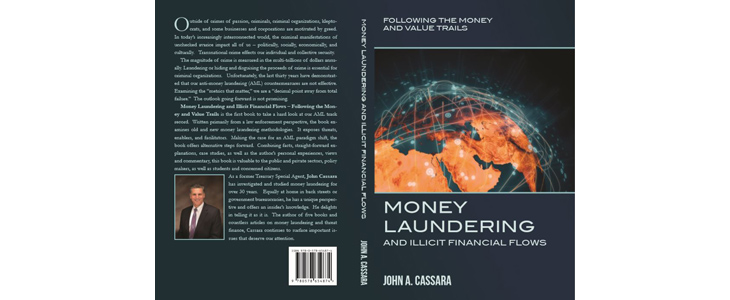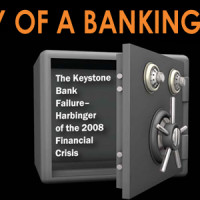
John A. Cassara is a man with a unique career in the area of anti-money laundering (AML), having worked on the frontline, in law enforcement internationally and in the U.S. government. During his law enforcement investigative career, he conducted an extensive number of money laundering investigations covering fraud, intellectual property rights, smuggling, diversion of weapons and high technology in Africa, the Middle East and Europe, for a variety of federal agencies. He began his career with the U.S. Treasury Department as a special agent assigned to the Washington field office of the U.S. Secret Service. During his time in U.S. Customs and Border Protection, he served two years as an undercover arms dealer. His last position was as a special agent to the Treasury Department’s Office of Terrorism and Financial Intelligence. He worked at the Financial Crimes Enforcement Network (FinCEN), the U.S.’ financial intelligence unit (FIU), between 1996 to 2002. From 2002 to 2004, Cassara was assigned to the U.S. State Department’s Bureau of International Narcotics and Law Enforcement Affairs in the AML section to help coordinate U.S. interagency international counter-terrorist financing (CTF) training and technical assistance efforts.
In his earlier books, On The Trail of Terror Finance: What Law Enforcement and Intelligence Officials Need to Know, he covered terrorist financing. He also wrote a novel based on terrorism titled Demons of Gadara and many consider his book Trade-Based Money Laundering: The Next Frontier in International Money Laundering Enforcement to be the textbook on the subject.
He has successfully harnessed his wide experience to write this latest fascinating book on AML and illicit financial flows covering a wide range of related topics with very extensive citations to references in the footnotes―in fact, a total of 557 throughout the book. Written in an extremely comfortable style, the book makes complicated topics easy to understand. In the narrative, he includes some remarkably interesting facts supported by references such as, “52% of Russia’s wealth resided outside the country,” “over the last decade, an estimated $3.8 billion in capital has left China” and “in 2010, between $21 and $32 trillion were hidden in more than 80 international tax havens.” He makes the case, very convincingly, that money laundering is truly a global problem.
A wide range of topics is covered. The opening chapters describe the global magnitude of the money laundering problem and, with respect to the effectiveness of the current AML infrastructure, he quotes Raymond Baker who said, “total failure is just a decimal point away.” (He used this same quote as the subtitle to a seminal paper he wrote in August 2017 called “Countering International Money Laundering” published by The Fact Coalition.1) The subsequent chapters include the traditional topics of bulk cash, trade-based money laundering, alternative remittance systems, shell companies and real estate, which are discussed in a clear and highly informative way. The chapter on trade-based money laundering describes something currently almost unknown in AML enforcement: service-based money laundering. He also describes a proposal he advanced—which the U.S. government adopted in 2004—called the Trade Transparency Unit, which is designed to share trade data between nations.
In other chapters, he covers other relevant topics that are not often mentioned such as the illicit tobacco trade, free trade zones, the gold trade and trade in technology such as cell phones. Throughout the book there are about 20 case studies that summarize the events and tactics used by the illicit actors in order to provide real-life examples and support important points.
Whilst each chapter discusses a certain aspect of AML and CTF from a global perspective, there is one very impressive exception titled “China: The Biggest Money Laundering Threat.” The 78 pages are devoted to a very comprehensive discussion on the many areas in which China is involved with money laundering. It covers the involvement of China in transnational crime, narcotics, counterfeit goods and intellectual property rights violations, illicit tobacco, human trafficking, wildlife trafficking, illegal logging, trade fraud, weapons proliferation, underground banking, black market exchanges, predatory lending and others, all supported with 173 references.
Another unique quality of this book is that Cassara uses his extensive and varied experience to offer suggestions as to how many of the issues could be addressed at the end of many chapters. His last chapter, called “More Forward Steps,” is replete with pragmatic ideas, at both global and international levels, devoted to that objective.
This book is essential to understanding the immense volume of global illicit flows of money and value and it represents a major contribution to money laundering education. It can appeal, very successfully, to many audiences from new AML professionals to law enforcement. This extraordinary new book by Cassara provides yet another example that he is one of the most significant thought leaders in the field of AML and CTF.
Money Laundering and Illicit Financial Flows: Following the Money and Value Trails is available for purchase on Amazon.
- John A. Cassara, “Countering International Money Laundering: Total Failure is ‘Only a Decimal Point Away,’” FACT Coalition, https://thefactcoalition.org/wp-content/uploads/2017/08/Countering-International-Money-Laundering-Report-August-2017-FINAL.pdf










